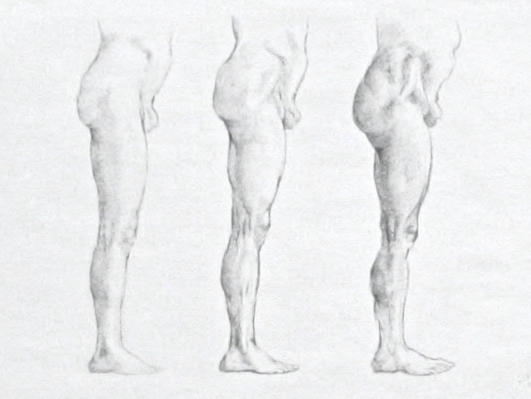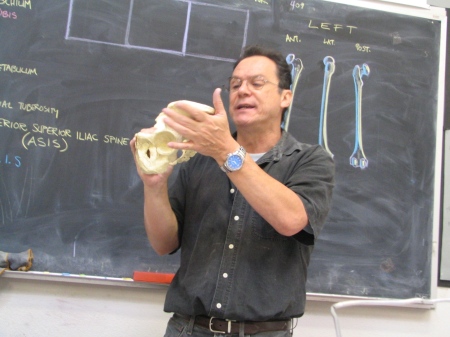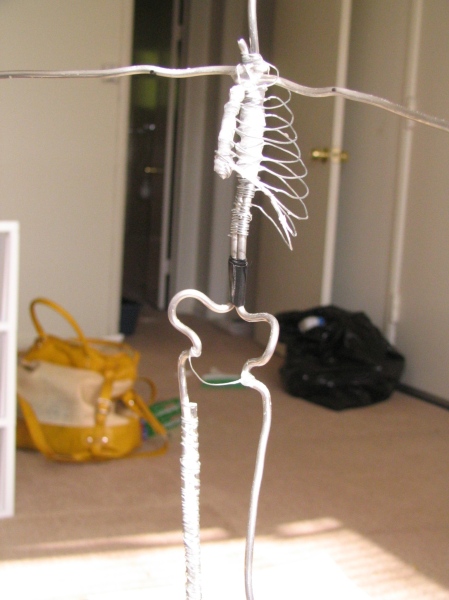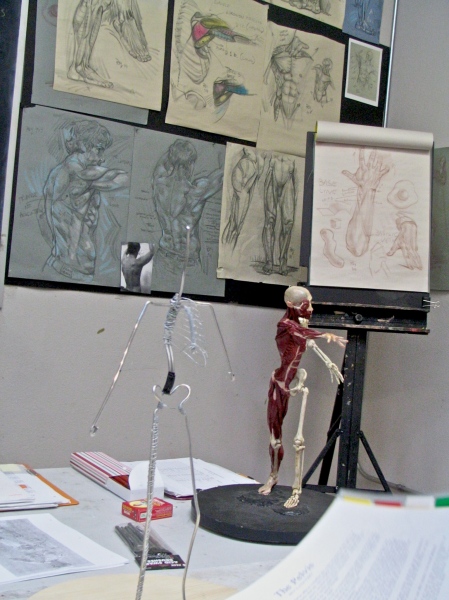 This fabulous leg bonanza is an exercise we did in Rey Bustos’s Analytical Drawing. Rey has taken to calling me his groupie, and perhaps this accusation is somewhat grounded in reality. In the spring term, I took his 3D Anatomy/Ecorche class, in the summer I took his 2D Anatomy, and now I’m taking Analytical Drawing to top it all off. Not only that, but I elbowed my way into the Analytical class as one of only 3 part-time students, because this course is in the full-time program, and I had to whine fight to get in.
This fabulous leg bonanza is an exercise we did in Rey Bustos’s Analytical Drawing. Rey has taken to calling me his groupie, and perhaps this accusation is somewhat grounded in reality. In the spring term, I took his 3D Anatomy/Ecorche class, in the summer I took his 2D Anatomy, and now I’m taking Analytical Drawing to top it all off. Not only that, but I elbowed my way into the Analytical class as one of only 3 part-time students, because this course is in the full-time program, and I had to whine fight to get in.
I am very happy I did, if only for this exercise alone. A lot of figure drawing teachers tend to teach a style (their own) and a shorthand for indicating anatomical information (also their own). Before I knew anything about anatomy, such a teaching approach was useful to me as a student, albeit in a limited way. I could put visual information into a drawing that helped the viewer recognize human features in it, even if I didn’t know what it was that I was putting in.
But once I learned all my fancy anatomy learnin’, the shorthand and styles of the teachers stopped working for me. Now on top of actual information about actual, real form, I was also memorizing arbitrary information and arbitrary ways to convey it. I found that when a teacher taught me to find anatomical goods myself, I could do it, but when they said, “here is a formula for a leg, just use it,” I couldn’t reconcile it with the actual leg in front of me or what I recognized in the leg and wanted to portray.
Another interesting problem I developed after learning anatomy has to do with style. Again, I used to have my own style of conveying what I see. But what I see is now different from what I used to see! That’s knowledge for you. It messes up your whole system of dealing with the world. Now my habitual stylistic flourishes don’t work anymore and I haven’t developed new ones yet.
This is where the triple-leg bonanza steps in. This exercise came after we spent several weeks learning the skeleton and muscle structure of legs, and did a bunch of ecorche drawings. Now, when the class sits down to draw from the model, everybody’s drawings tend to look like skinless people! The stylistic breakdown has occurred. We think about bone and muscle, about what’s inside the leg, so we draw that instead of the outer form. It’s a normal stage in the life of an artistic anatomy student. This exercise is designed to move us past that and to help us develop our own new way of drawing the leg – informed by what’s inside, and showing evidence of what’s inside, but actually depicting the visible, outside form. And doing so in a visual language that is uniquely ours, a recognizable individual style that arises out of an individual perception.
It’s very interesting how the Renaissance not only brought the individuality of the viewer into the picture, by using perspective and showing an image as seen from a specific vantage point, but also made it impossible for artists to be anything other than individuals in how they went about producing images. Once you learn anatomy, you can’t draw to a predetermined canon. You have to find a way to articulate what you see, because you can’t unsee it in favour of an externally imposed system. If you draw from anatomical knowledge, you are forced to develop your own pictorial language, and the hand that is visible in the drawings becomes as unique as fingerprints. That’s a huge difference from anonymous workshops making works that also look anonymous (like Egyptian frescoes, for example).
So back to the triple-leg threat: the exercise was to draw specifically a skin-possessing, normal-looking leg, and we had to do it from imagination rather than live model or reference. Because we drew from imagination, we had to rely on internalized information and cement that memory further. Because we drew a normal leg rather than an anatomical chart, we had to grapple with how to show anatomical information in a realistic drawing. But why the three legs, you say? Why, why, why? Well, that’s where we got to play with style. Leg #1 had to be a roughly normal leg. Leg #2 had to have the muscle articulation dialed up a bit, going from a mellow interpretation to someone more jazzy, like Raphael, who would emphasize musculature while still keeping the overall gist of the drawing relatively grounded. Leg #3 is in Michelangelo territory – a beef festival! You can see that my natural sensibility is somewhere between 1 and 2 – my heavy metal leg is not especially loud or bumpy. Some people created terrifying and magnificent bump landscapes with their Leg #3, and it was a lot of fun to look at them.
The exercise result is a boring and weird-looking drawing, but it’s a fantastic journey that trains some very important mental muscles. The idea of this exercise can be applied in other art exploration – take a material or a subject, and do a range of pieces that explore just how far you can push the technical aspect of something, or the intensity of a stylistic approach, going from subtle and quiet to roaringly insane. Or in my case, mildly louder than before.






